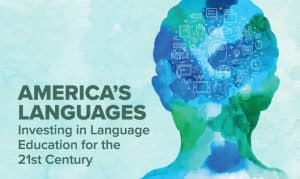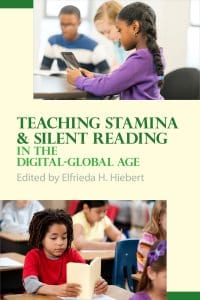 Peter Foltz, Eric Hilfer, Kevin McClure, and Dmitry Stavisky explain what artificial intelligence (AI) means for the teaching of language and literacy
Peter Foltz, Eric Hilfer, Kevin McClure, and Dmitry Stavisky explain what artificial intelligence (AI) means for the teaching of language and literacy
Peter Foltz:
Artificial intelligence is doing something that is human-like, doing things that appear human in terms of performance, although more recently, it’s become more associated with some of the modern kinds of machine-learning-type approaches, using large amounts of data.
You don’t want to think about AI as being general intelligence like a human’s. It works within a narrow domain and it tends to be applied in specific areas, but the term has become very widely used for anything where there’s some kind of decision-making process done by computers.
There are several different kinds of things that AI is able to do for language learning and literacy. One of the areas I think is key is the assessment of more open-ended responses, of things that beforehand were thought to be only at the level that could be assessed by humans. In automated essay evaluation, as well as automated spoken-language assessments, we can assess a wide range of different traits of the language used—so for writing, you can look at not just the quality of the writing or grammar, but you can also assess content knowledge and whether the student is able to understand the domain as well as able to express in the way that you would expect for a person at that level of language ability.
So that gives a way of not just awarding a grade but being able to say, “Here are some of your strengths and weaknesses—you seem to need to do more work on this content,” or “you’re strong in these areas, but you need to work on your writing style, or your organization.” We can do that similarly with spoken language, where we can ask students to speak and we get information back about their fluency, pronunciation, and mastery of sentences, vocabulary, those kinds of information.
Here’s an example from the writing side that applies equally well for the spoken side: When a student writes an essay, we’re comparing that essay against anywhere from hundreds to thousands of other essays that have been written on that topic or in that domain for which we already have scores. The computer breaks down that essay into 15 to 100 different language features. Some of them may be around word usage; some may look at sentence structure; some look at larger overall structures; some may look at grammar.
Then, we have a variety of AI-based techniques that can actually assess content, not just at the keyword level but at the semantic or meaning level, so we can assess if the way a student expresses meaning is similar to the way other students have done it. We can either do that for scoring on a particular topic, comparing against essays that other students have written about that topic, or, more generally for language ability, we can compare against other students who were at the same or different levels of language ability.
We believe it’s not good enough just to score student responses—we also need to know when the scoring engine doesn’t know how to score well, so when it’s evaluating, it’s also looking at all those features and asking: “Have I seen responses like this before?” If they look highly unusual, then it sends it to the instructor or rater for scoring. We don’t like to take the control away from the instructor but prefer to create something that works with an instructor but only marks what it’s confident about. It can even learn from the instructor’s marking and gain the confidence to know what to do next time.
There’s a product just coming out called Tell Progress, which is a tablet-based assessment system where students are asked to speak or write. They listen and then have to repeat back or summarize what they’ve heard, or they might be able to hear some verbal instructions and then have to interact with the system in a variety of ways. And so, it provides a way to look at English language abilities across reading, writing, speaking, and listening. We’re incorporating both automated writing analysis in that and automated spoken-language analysis.
This technology is really well suited for the formative side because it allows for a much greater level of one-to-one tutoring, where it can assess what a student says, or what a student writes, and then give feedback to the student. The student can then learn from it, revise it, and continue on. For example, in some of our writing applications, students can submit multiple drafts because they can write something, submit it, and instantly, within about a second, get feedback both about the quality of the writing and about the quality of the content that they’re covering.
It’s then tied into instructional material that allows them to dig deeper. So, for example, if it says you scored low on organization, it will then take you into some extra training on how to organize writing better. Students can then go back, revise, and resubmit. In about an hour, students will often generate four or five drafts that have been marked by the engine, but it doesn’t remove the instructor from that because the instructor has a dashboard where he or she can keep track of what the student is writing. The student can still submit the final draft to the instructor but gets much more time to interact and get feedback in real time.
I don’t see AI as a replacement for the teacher but I see it as a way to provide students with a lot more independent time interacting and getting feedback. With language learning, one of the best ways to learn is to get very quick feedback on writing or speaking, but students don’t get enough opportunity interacting one on one with instructors.
This is not really designed to replace the instructor, but the instructor doesn’t have time in a class of 30 students to interact with each one of them regularly. It allows students to interact with something that can give them fairly direct feedback with some ways to improve while keeping the instructor in the loop because the instructor is still getting information on how the student is doing. So, I see AI as a way of multiplying what an instructor can do while the instructor remains just as involved with the class.
Dr. Peter Foltz is VP in Pearson’s Advanced Computing and Data Sciences Laboratory and research professor at the University of Colorado’s Institute of Cognitive Science. His work covers reading comprehension and writing skills, 21st-century skills learning, large-scale data analytics, artificial intelligence, and uses of machine learning and natural language processing for educational and clinical assessments.
Eric Hilfer:
Language is among the first things we learn as humans, undertaking a complex multiyear process that is key to our survival as social creatures.
As children, humans acquire all the aspects of their native language(s) including the sound system, the meaning of words, and the rules for forming sentences. At older ages, such as in adult learning, languages may be learned more formally—through instruction and explicit explanation of a new language’s structure.
This learning “about” language seems quite different from naturally “picking up” a language from the environment—and there is evidence that these two types of learning, in fact, rely on different underlying brain systems. In both cases, however, fluency and full ability to use the language come only with extensive practice speaking the language to communicate. Immersion is an ideal way to get this practice, but it’s not practical or available for all learners.
Artificial intelligence (AI) and machine learning have great potential to provide targeted speaking practice for many adult learners. Machine learning has long been the cornerstone of speech recognition for the automation of speaking instruction and targeted pronunciation training. AI instructional models are trained on real student behavior and subsequent achievement. These hold the promise of providing tireless, individualized instruction, giving learners the large volume of feedback and scaffolded practice needed to achieve fluency, all within a low-stakes environment where learners are more willing to take risks and make mistakes.
With the advent of cheaper processing, deep neural networks (DNN) have surpassed expectations and are increasingly available to solve a broader set of problems. A deep neural network is a mathematical construct that encodes a multilayered transformation of raw data into useful patterns, based on structured feedback. In the past, the process of training a small DNN with several layers could take hundreds of hours without yielding a useful result. With advances in computing and innovation in training algorithms, more accurate DNNs with as many as a thousand layers have become an area of intense interest in learning science. This has sparked an era of rapid innovation as these tools become easier to adopt, adapt, and apply.
One of the wonderful challenges and opportunities before language teachers today is figuring out how to best use technology to harness what we know about the brain and how machine learning, DNN, and AI can individualize the learning experience to meet learners exactly where their brains are in the language-acquisition process.
It’s something we’re taking a closer look at as we consider future innovations to our own language-learning programs at Rosetta Stone. AI has the potential to integrate many new features and capabilities to improve the learning experience for language learners. For example, with AI we can mix teaching approaches, as appropriate, for each learner in each skill at the current moment.
Since mastering a new language—whether it’s your first, second, third, or beyond—is not a short process and requires commitment to successfully achieve, the great promise of AI is that it can shorten the time to gain proficiency. For example, one could use AI to determine when learners have mastered content and allow them to skip ahead to new material as appropriate. This in turn helps get learners to elementary and intermediate levels of competence more quickly, making them functional users of the language faster. Conversely, AI can allow us to determine where a learner is struggling and provide remediation to get them over the hump and back on track.
Another promise of AI is that it can more seamlessly determine learners’ interests and provide them with content that matches their personal needs.
That is, we can use AI to discover learners’ interests without intrusive surveys that take time away from learning. And when we provide learners with content that is engaging and speaks to them personally, they spend more time learning and achieve more.
AI can also provide an invisible match between taught content and assessment, ensuring that a system tests learners on what they have learned, and then use the results of the assessment to further personalize the learning.
It’s important to note that AI need not push the expert teacher out of the learning equation. Rather, AI should be viewed as a powerful resource with the promise to enable teachers with insights into where learners need additional help or are ready for bigger challenges.
It also has the potential to support interactions between students, helping to group them by level and interest for more interesting, fruitful, and educational interactions.
Eric Hilfer is vice president of product development at Rosetta Stone.
Kevin McClure:
I have a very optimistic view of how AI will affect language learning that is based on my experience at DynEd International, where we are dedicated to blended learning.
AI-powered courseware takes care of the more mundane tasks involved in language learning so that teachers or coaches can spend class time having learners doing communicative activities—for example, discussions or simulations.
AI allows the digital courseware to address the individual needs of learners at a level that is difficult to achieve in a classroom.
Examples of this include:
- Starting learners at a course level that is appropriate for their individual needs;
Identifying what learners already know so that practice of those concepts and content is limited, - Identifying learners’ weaknesses so that they receive extra presentation and practice of those concepts and content;
- Providing clear goals for the learner;
- Laying out a course of study for the learner, ordering the activities in a way that helps each individual learner master key concepts and content quickly;
- Providing learners with a reasonable number of choices that allows learners some degree of control over their learning, based on their learning styles and personal preferences;
- Giving individual learners advice about how to use the courseware most effectively—for example, to record their speech more often with speech recognition (SR) technology;
- Giving each learner immediate feedback on his or her comprehension of the content and concepts;
- Giving instructors detailed information on how the learners in their classes are progressing and how effectively they are using the courseware;
- Guiding learners through activities in a brain-effective manner,
meaning that new concepts and content are repeated in a variety of ways until learners demonstrate mastery; - Coordinating communication between courseware and instructors so that learners are prepared for live sessions with instructors because they have mastered the concepts and content they will need for their upcoming classes or coaching sessions.
David Nunan, the renowned researcher in ELT, has always maintained that AI-driven courseware should be seen as a great boon for teachers, as it will relieve them of teaching chores such as explaining grammar rules or practicing sentence patterns.
I share his positive view and look forward to an ELT future in which teachers are given the information on individual learners that they need to optimize their students’ progress.
Kevin McClure is DynEd’s AI and assessment lead. He has a master’s degree in applied linguistics and has 36 years of experience in all aspects of English language teaching.
Dmitry Stavisky:
Mastering a foreign language requires a lot of practice. Self-study is usually inefficient, and one-to-one teacher-led lessons are very expensive. So public and private schools resort to more affordable group lessons. Unfortunately, group format is not optimal for language learning. Learning a foreign language while surrounded by people at the same minimal fluency level does not work. As a result, in many countries, we see low foreign language fluency despite students spending a lot of time and money on foreign language learning.The good news is that any of these tasks can be partially or completely automated using artificial intelligence technologies. I believe the best way to teach a language is to provide every student with personalized one-to-one tutoring. By combining advanced machine learning, natural language understanding, and speech technologies with on-demand human instructors, innovative language-learning services like Edwin provide more effective, and much more affordable, teaching than traditional language-learning techniques.
At Edwin, we rely on AI-powered bots and voice assistants to do the bulk of English teaching and language practice, freeing teachers to use their valuable time for the most nuanced tasks. In other words, we don’t digitize classrooms, lectures, and books. We break the language knowledge graph down to the concepts and skills, develop personalized learning plans, and teach these concepts and skills to every student individually. This approach will allow us to get Edwin students to proficiency in one-third the time and for one-third the cost of cram schools, currently the most common way to prepare for English tests.
There is no silver bullet in foreign language learning, but we can already see that artificial intelligence is radically changing the economics of language education. It helps students and teachers move from factory-model classrooms and methodologies to more effective, personalized education.
Dmitry Stavisky is co-founder and CEO at Edwin.ai, an innovative education-technology company helping people around the world learn English.




 In support of its recent report,
In support of its recent report,  The Lower Kuskokwim School District (LKSD) is roughly the size of West Virginia, with 22 schools spread across a remote area of Alaska’s Yukon Delta National Wildlife Refuge. There are no roads, and the most common ways to travel between towns are to fly or snowmobile.
The Lower Kuskokwim School District (LKSD) is roughly the size of West Virginia, with 22 schools spread across a remote area of Alaska’s Yukon Delta National Wildlife Refuge. There are no roads, and the most common ways to travel between towns are to fly or snowmobile.
 For the last 30 years, the world economy has been more global and multicultural than ever before. In any given country, foreign-based companies operate every day, while overseas branches of the same companies are often present in various countries. The job market is consequently more global, multilingual, and multicultural in nature, and the workforce of the future will need to be more linguistically and culturally heterogeneous.
For the last 30 years, the world economy has been more global and multicultural than ever before. In any given country, foreign-based companies operate every day, while overseas branches of the same companies are often present in various countries. The job market is consequently more global, multilingual, and multicultural in nature, and the workforce of the future will need to be more linguistically and culturally heterogeneous.
 Richard Lederer celebrates “the most impressive collective achievement of our civilization”
Richard Lederer celebrates “the most impressive collective achievement of our civilization” Elfrieda H. Hiebert offers literacy advice
Elfrieda H. Hiebert offers literacy advice The National Center for Education Statistics has found that approximately two-thirds of eighth-grade students in the U.S. cannot read proficiently (https://nces.ed.gov/programs/coe/pdf/coe_cnb.pdf), a figure that has held relatively steady for 25 years. To help schools and districts close the achievement gap for nonproficient readers in grades six and above, Lexia Learning has released PowerUp Literacy, designed to simultaneously accelerate the development of both fundamental literacy skills and higher-order thinking skills through adaptive learning paths.
The National Center for Education Statistics has found that approximately two-thirds of eighth-grade students in the U.S. cannot read proficiently (https://nces.ed.gov/programs/coe/pdf/coe_cnb.pdf), a figure that has held relatively steady for 25 years. To help schools and districts close the achievement gap for nonproficient readers in grades six and above, Lexia Learning has released PowerUp Literacy, designed to simultaneously accelerate the development of both fundamental literacy skills and higher-order thinking skills through adaptive learning paths. Roberto Rivera explores the vital connection between social and cultural competence—for both students and teachers
Roberto Rivera explores the vital connection between social and cultural competence—for both students and teachers

 Socio-economic disadvantage and language barriers are the biggest obstacles to success at school and in society for students with an immigrant background. More effective and better targeted education and social policies are needed to help migrant children integrate and fulfil their potential, according to an OECD report.
Socio-economic disadvantage and language barriers are the biggest obstacles to success at school and in society for students with an immigrant background. More effective and better targeted education and social policies are needed to help migrant children integrate and fulfil their potential, according to an OECD report.